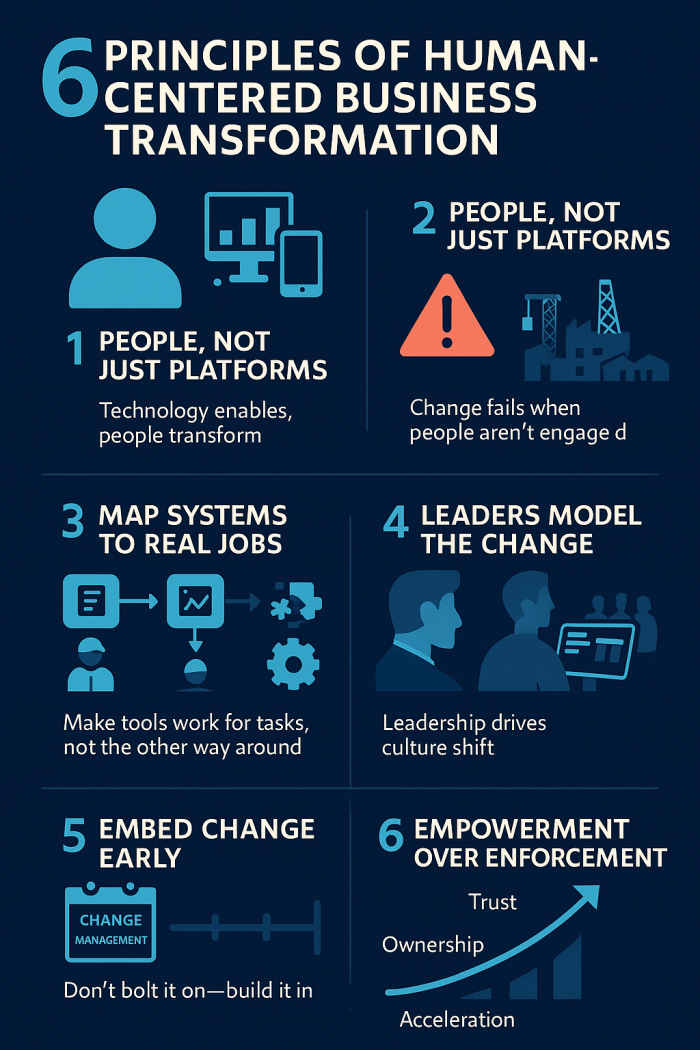Technology Doesn’t Transform. People Do.
Digital platforms don’t change companies. People do. Yet too many transformation programs invest heavily in systems and barely at all in people. The assumption? If we build the tools, adoption will follow. But in mining, oil & gas, and heavy equipment sectors—where change meets field resistance and legacy thinking—transformation must be framed as a human journey, not just a technical upgrade.
The Human Bottleneck in Every System Rollout
It’s not uncommon for multi-site enterprises to invest in ERP, BI, or automation tools, only to see usage plateau or quietly fail. Why? Because frontline teams weren’t prepared. Middle managers weren’t engaged. Site leaders weren’t aligned. And executives underestimated the cultural shift required. Resistance isn’t irrational—it’s often a rational response to unclear benefits, added complexity, or fear of obsolescence.
Engagement Starts With Understanding Jobs, Not Just Systems
Transformation must meet people where they are—on the job, in the field, at the console. That means mapping new systems to real roles: how a planner orders stock, how a supervisor logs downtime, how a foreman checks equipment status. When new processes make life harder—or less intuitive—resistance sets in. But when digital tools eliminate friction and improve outcomes, people embrace the change. Adoption is emotional before it is procedural. Employee engagement in digital change plays a crucial role in this transition.
Leadership as Enabler, Not Enforcer
Executives must stop viewing transformation as a compliance effort and start seeing it as a leadership function. In successful programs, C-suite leaders don’t just approve the budget—they champion the purpose. They communicate vision, remove blockers, reward engagement, and model usage. When field teams see leaders using dashboards, referencing data, and speaking the new operational language, trust builds and culture shifts. The role of the executive team in a transformation is a critical success factor.
Change Management Isn’t a Department—It’s a Discipline
Many organizations treat change management as a late-stage communications campaign. But real transformation requires it from the start—embedded in design, training, pilot rollout, and ongoing feedback loops. Site champions, super-user programs, coaching support, and feedback analytics must all be part of the change infrastructure. You can’t “manage” change after it’s delivered—you must design for change from day one. Change management best practices can help ensure long-term adoption and impact.

Empowerment Through Capability, Not Just Compliance
When transformation is human-centered, employees don’t just adopt—they accelerate it. Operators use dashboards to make smarter adjustments. Planners optimize maintenance cycles. Managers reforecast in real time. When people understand, trust, and feel ownership over the tools, transformation becomes self-reinforcing. Empowerment—not enforcement—is what drives momentum. Digital transformation strategy should prioritize people, not just platforms.
Digital Transformation Is Culture Change at Scale
Ultimately, the biggest lever in any transformation is belief. Belief that the change is worth it. That it’s possible. That it’s led by example. And that it makes people more effective, not replaceable. Technology enables transformation—but it’s your people who sustain it, extend it. Organizational culture change depends on collective human commitment.
